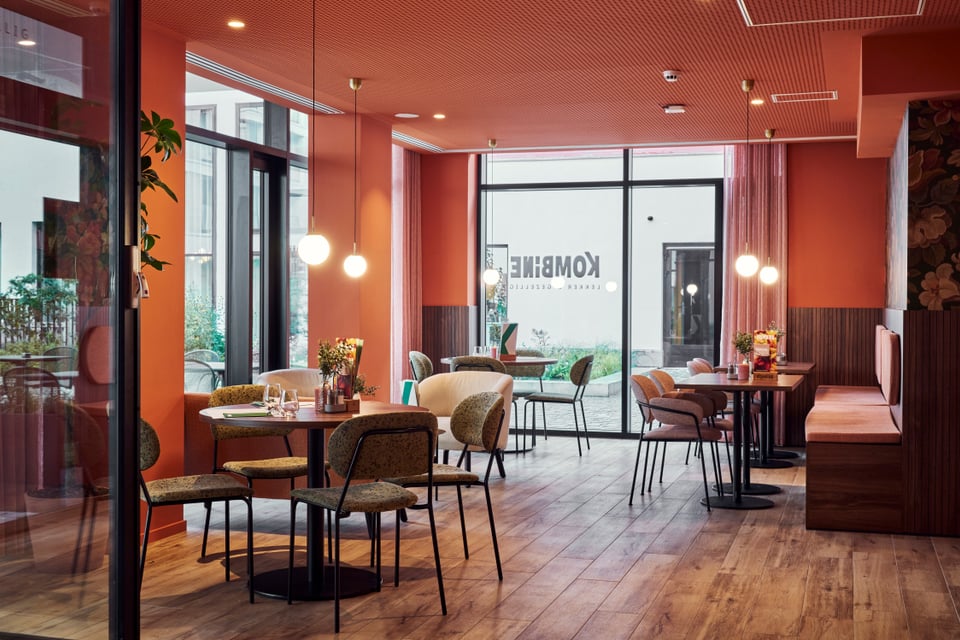ANTWERP SOCIAL TABLE: WHERE GENERATIONS GATHER
How sensory design transformed a care home canteen into Antwerp’s most inclusive meeting place
THE CHALLENGE: BEYOND THE TYPICAL CARE HOME CANTEEN
Most care homes settle for functional but uninspiring dining spaces. Zorgbedrijf Antwerpen had a different vision: create an authentic, welcoming brasserie with true restaurant quality—a place where residents, local students, families, and shoppers would genuinely want to gather. The project is named Kombine, a play on the Dutch word “kom binnen” (come in).
It perfectly captures what this space is: a warm invitation to come together, to step into a place where everyone is welcome. No thresholds, no barriers – just an open door and a table waiting for stories, conversations, and connection.
The brief was clear but complex: transform a partially new-build, partially renovated space into a warm, accessible destination for audiences ranging from 8 to 88 years old. It needed to function efficiently for staff, comply with all regulations, and above all—avoid the cold, sterile feel of typical new construction.
The client’s fear? “A chilly new-build restaurant without that cozy, homey feeling.”
THE INNOVATION: DESIGNING WITH ALL FIVE SENSES
Studio Kimchi, the Ghent-based interior architecture firm behind the project, approached the challenge with a radical premise: visual design accounts for only 50% of spatial experience.
“In public spaces, it’s crucial to engage all five senses to maximize the experience,” explains Ischa Van Putte, founder of Studio Kimchi. “Most architecture and interior design focuses exclusively on the visual, but we went further.”
The sensory strategy:
SIGHT: A carefully balanced aesthetic drawing from the building’s architecture (open patios, new-build combined with nostalgic materials) and the surrounding neighborhood’s fascinating mix of historic core (pedestrian tunnel, Kloosterstraat) and modern development (Scheldekaai, Zuiderterras).
SMELL: All dishes are prepared fresh on-site, from morning coffee service to three-course lunch menus. The aromas of locally sourced, freshly cooked food became a deliberate design element—a powerful factor in restaurant ambiance.
SOUND: Acoustic treatment received special attention. “Nothing is more frustrating than struggling to hear each other,” notes Van Putte. “Many residents experience hearing loss, so acoustic comfort was non-negotiable.”
TOUCH: The most challenging aspect. Balancing maintenance-friendly materials with tactile richness, the team deliberately chose varied textures: upholstered chairs, wooden tabletops, terracotta tiles—all treated with maintenance-friendly finishes to reconcile functionality with sensory experience.
TASTE: The culinary program spans multiple dining phases: coffee house in the morning, café/aperitif bar with terrace in the afternoon, snacks, à la carte lunch, and three-course midday menus—all locally sourced and prepared.
THE CONCEPT: NOSTALGIC MODERNITY
Through extensive research into location, circulation patterns, target audiences, architecture, and culinary programming, Studio Kimchi identified a fascinating trend shared across demographics: the search for balance between nostalgia and contemporary comfort.
“Students scour second-hand markets for vintage objects to combine with modern colors and décor,” observes Van Putte. “Older people treasure objects with emotional-nostalgic value but seek contemporary comfort. Both can be interpreted as ‘nostalgic modern’ and ‘modern nostalgia.'”
This tension became the conceptual foundation—a design language that makes 18-year-old students and 88-year-old residents feel equally at home.
THE IMPACT: A NEW MODEL FOR SOCIAL INFRASTRUCTURE
Antwerp Social Table represents more than an interior renovation. It’s a case study in how public investment in quality design can generate measurable social returns:
✓ Combating loneliness through intentional design for social interaction
✓ Bridging generational divides with inclusive, accessible aesthetics
✓ Elevating care home standards beyond functional minimums
✓ Creating neighborhood anchors that serve broader communities
✓ Demonstrating ROI of design in public health and social cohesion
The project was delivered turnkey in collaboration with main contractor Aksis, ensuring flawless execution of the high-quality design vision.
WHY THIS MATTERS NOW
As populations age and urban loneliness intensifies, Antwerp Social Table offers a replicable model: social infrastructure that serves multiple generations, designed with scientific rigor and creative ambition.
It challenges the assumption that care facilities must settle for “good enough” environments, proving instead that exceptional design is not luxury—it’s essential social investment.
Questions and Answers
How does the Antwerp Social Table specifically facilitate genuine connection between Gen Z and seniors? What unique benefits have you observed from these intergenerational interactions, both for the younger and older participants?
HOW ANTWERP SOCIAL TABLE FACILITATES INTERGENERATIONAL CONNECTION
DESIGN STRATEGIES THAT BRIDGE GENERATIONS:
1. SHARED AESTHETIC: “NOSTALGIC MODERN”
Our research revealed both Gen Z and seniors seek the same balance: authenticity that honors heritage with contemporary comfort. Students hunt vintage markets for old objects to style with modern colors; seniors treasure nostalgic pieces but want modern functionality. We designed for both simultaneously—warm, tactile materials (wood, terracotta, fabric) with clean, contemporary lines. Neither group feels like a guest; everyone feels at home.
2. SENSORY DESIGN TRANSCENDS AGE
Our five-sense approach creates universal appeal:
– Smell: Fresh, locally prepared food appeals to all ages
– Sound: Acoustic design for hearing loss benefits everyone—conversations flow naturally
– Touch: Varied textures satisfy Gen Z’s appetite for authenticity and seniors’ desire for comfort
3. FUNCTIONAL PROGRAMMING CREATES NATURAL OVERLAP
Multiple daily phases attract different demographics organically:
– Morning coffee → residents + students
– Lunch service → mixed groups, families
– Afternoon café/terrace → social gatherings across ages
– Event hall → community programming
No forced integration—just organic coexistence with natural opportunities for spontaneous interaction.
4. SPATIAL LAYOUT WITHOUT SEGREGATION
Varied seating (intimate two-tops, communal tables, terrace) offers choice while maintaining proximity. No “senior section” or “youth area”—age becomes incidental rather than defining.
BENEFITS OBSERVED:
FOR SENIORS:
✓ Reduced isolation through daily exposure to younger energy and perspectives
✓ Sense of relevance—part of contemporary life, not set apart
✓ Cognitive stimulation from diverse conversations and social dynamics
✓ Dignity through normalization—they’re diners and neighbors, not “the elderly”
✓ Opportunities for informal mentorship and storytelling
FOR GEN Z:
✓ Access to wisdom, perspective, and lived experience in an anxious era
✓ Breaking down ageist stereotypes through regular, normalized contact
✓ Positive models of healthy, engaged aging
✓ Community belonging in increasingly transient, digital lives
✓ Quality, affordable dining in a meaningful setting
THE KEY INSIGHT:
Genuine intergenerational connection doesn’t require programming—it requires removing barriers.
Most spaces segregate by age through aesthetic choices, functional limitations, or cultural coding. We inverted this: design for universal human needs (comfort, beauty, acoustic clarity, sensory richness) and let connection emerge naturally.
The result isn’t a “senior center tolerating young people” or a “hip café accommodating elderly.” It’s genuinely shared space where age becomes incidental.
THE TAKEAWAY:
Antwerp Social Table proves design is social policy. By creating spaces that honor dignity and engage all senses, we build infrastructure that actively generates social capital and combats isolation.
The interactions between Gen Z and seniors aren’t remarkable because they’re engineered—they’re remarkable because they’re normal. That normalization is the project’s greatest success.
Could you elaborate on the “sensory design” elements implemented in the care home tavern? How do these specific design choices contribute to creating a vibrant social hub and encourage interaction among diverse age groups?
SENSORY DESIGN IN ANTWERP SOCIAL TABLE
The core principle: Visual design accounts for only 50% of spatial experience. Most interiors focus exclusively on aesthetics, but we engaged all five senses to create deeper connection and interaction.
THE FIVE-SENSE STRATEGY:
SIGHT: Nostalgic Modern Aesthetic
We drew from the building’s architecture (open patios, new-build with nostalgic materials) and Antwerp’s unique mix of historic core and modern development. Warm, tactile materials—wooden tabletops, terracotta tiles, upholstered chairs—combined with clean contemporary lines. This creates visual common ground where 18-year-olds and 88-year-olds both feel at home.
SMELL: Fresh, Local Cuisine as Design Element
All dishes are prepared fresh on-site throughout the day—morning coffee, à la carte lunch, three-course menus. The aromas of locally sourced, freshly cooked food became a deliberate design tool. It’s a sensory language everyone speaks, triggering comfort, appetite, and positive associations that draw people in and encourage lingering.
SOUND: Acoustic Comfort for All
We prioritized acoustic treatment specifically for residents with hearing loss—but the result benefits everyone. Clear, comfortable sound levels mean students can study, families can converse, professionals can meet. **Good acoustics don’t feel like accommodation; they feel like quality.** When people can hear each other effortlessly, conversations flow and connections deepen naturally.
TOUCH: Tactile Richness Meets Practicality
The biggest challenge: balancing maintenance requirements with tactile warmth. We deliberately chose varied textures—fabric upholstery, natural wood, terracotta—all treated with maintenance-friendly finishes. Gen Z appreciates the authenticity and craftsmanship; seniors enjoy the tactile comfort that evokes memory and warmth. Texture invites interaction and makes spaces feel lived-in, not institutional.
TASTE: Multi-Phase Culinary Programming
The dining program spans the full day: coffee house (morning), café/aperitif bar with terrace (afternoon), snacks, lunch à la carte, three-course menus. This variety attracts different demographics at different times, creating natural overlap and organic intergenerational mixing.
HOW THIS CREATES A VIBRANT SOCIAL HUB:
Sensory richness = longer stays
When spaces engage multiple senses, people naturally linger. The combination of appealing aromas, comfortable acoustics, and tactile warmth makes the space feel inviting rather than transactional.
Universal appeal removes barriers
By designing for fundamental human needs (not demographic stereotypes), we created space where age becomes incidental. A student drawn by fresh coffee and good acoustics for studying sits near a senior enjoying the nostalgic-modern aesthetic—both feel the space was designed for them.
Sensory cues encourage exploration
The smell of fresh food draws people from other areas of the care home and the neighborhood. Varied textures and seating types invite people to try different zones, increasing chance encounters.
Comfort enables connection
When acoustic strain is eliminated, when materials feel pleasant to touch, when aromas are appealing—people relax. And relaxed people are open to spontaneous conversation and connection.
THE RESULT:
Sensory design transforms a functional dining space into a destination—a place people choose to be, not just pass through. By honoring how humans actually experience space (through all senses, not just vision), we created an environment where diverse age groups naturally converge, linger, and connect.
It’s not about forcing interaction—it’s about removing the sensory barriers that typically keep people isolated, even in shared spaces.

